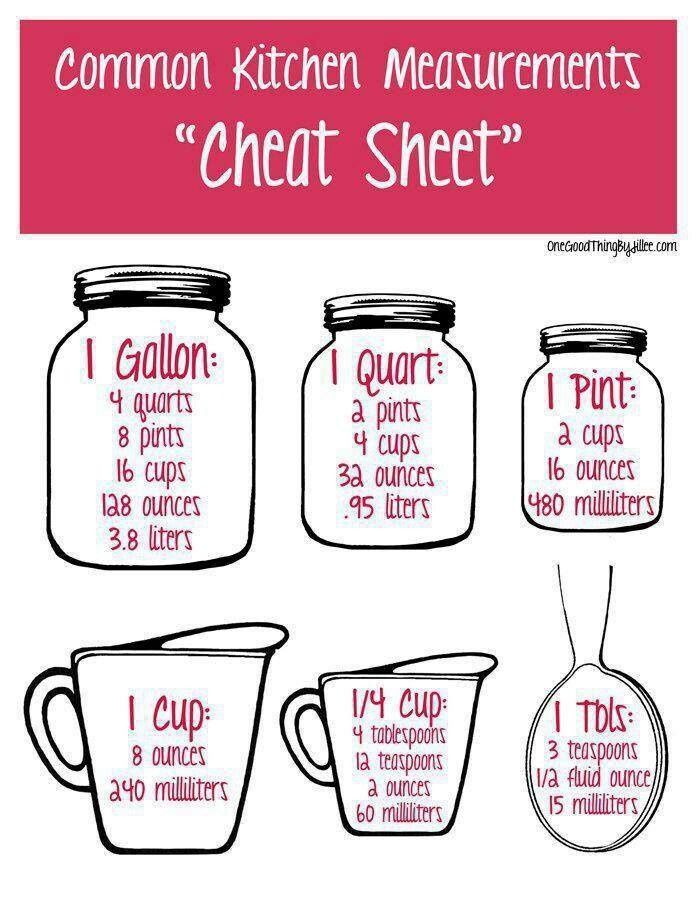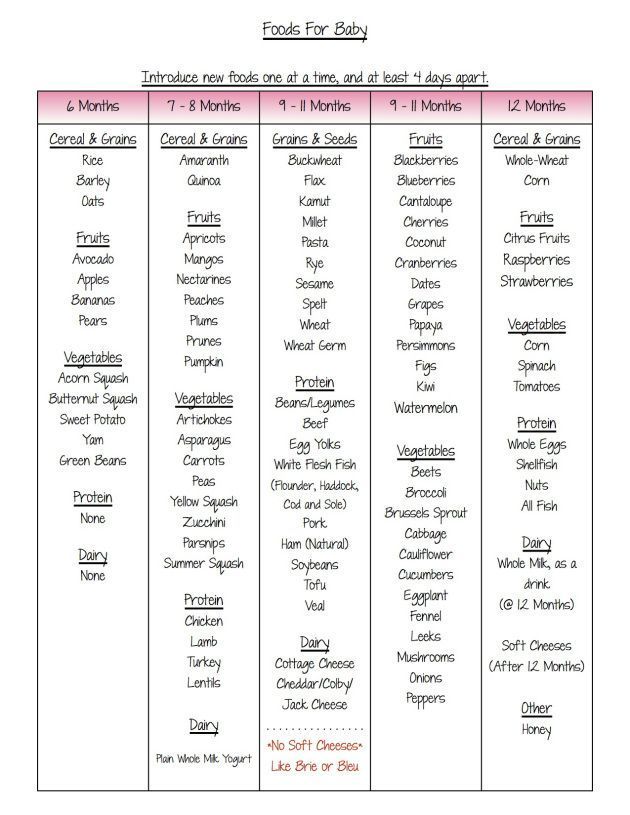New born baby food chart
Baby formula feeding chart: How much formula by weight and age
Is your baby getting too much or too little formula? It's an important question that worries many new parents, especially those with newborns. When deciding how much formula to give your baby, it's important to watch their hunger cues as well as looking at guidelines based on age and weight. In general, before they're eating solids, babies need 2.5 ounces of formula per pound of body weight each day.
These guidelines are for babies who are exclusively formula-fed for the first 4 to 6 months, and then fed a combination of formula and solids up to age 1. If your baby is getting a combination of breast milk and formula, talk to their doctor for separate advice.
Your pediatrician can tell you where your baby falls on the growth charts, make sure they're growing steadily on their own growth curve, and help you ensure that they're getting a healthy amount of formula. If you're ever worried about your baby's growth, behavior, or development, talk with their doctor.
How much formula for a newborn
For the first few days, offer your newborn 1 to 2 ounces of formula every 2 or 3 hours. (At first, newborns may only take a half ounce of formula at a time.)
After the first few days, give your newborn 2 to 3 ounces of formula every 3 to 4 hours.
Initially it's best to feed your formula-fed newborn on demand, whenever they show signs that they're hungry. Because your little one can't tell you when they want a bottle, you'll need to learn to read their hunger cues. Crying is often a late sign of hunger, so if you can, try to catch the earlier signs that it's time for a feeding.
Here are some hunger cues to watch for:
- Smacking or licking their lips
- Rooting (moving their jaw, mouth, or head in search of food)
- Putting their hands to their mouth
- Opening their mouth
- Fussiness
- Sucking on things
- Becoming more alert
- Crying
As time passes, your newborn will begin to develop a fairly regular feeding schedule. You'll become familiar with their cues and needs, and knowing when and how much to feed them will be much easier.
You'll become familiar with their cues and needs, and knowing when and how much to feed them will be much easier.
Formula feeding chart by weight
During the first 4 to 6 months, when your baby isn't eating solid foods, here's a simple rule of thumb: Offer 2.5 ounces of formula per pound of body weight every 24 hours, with a maximum of about 32 ounces.
Advertisement | page continues below
| Weight | Ounces of formula |
|---|---|
| 6 pounds | 15 fl oz every 24 hours |
| 7 pounds | 17.5 fl oz every 24 hours |
| 8 pounds | 20 fl oz every 24 hours |
| 9 pounds | 22.5 fl oz every 24 hours |
| 10 pounds | 25 fl oz every 24 hours |
| 11 pounds | 27.5 fl oz every 24 hours |
| 12 pounds | 30 fl oz every 24 hours |
These numbers aren't rigid rules. They offer a rough estimate for what your baby may need.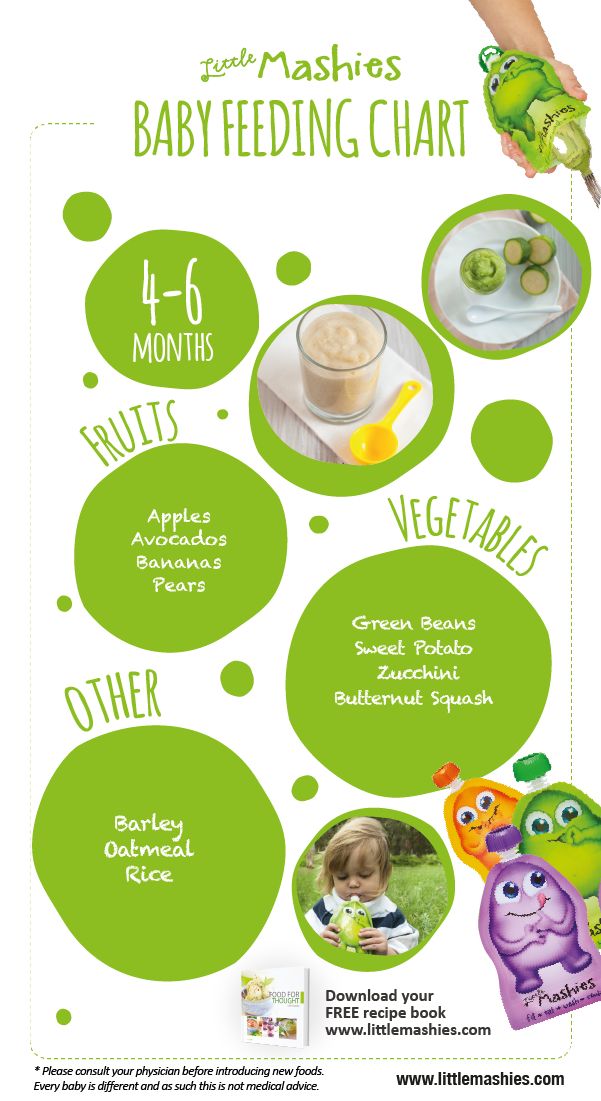 Some babies will grow well while taking less than the recommended amount, while others consistently need more. Your baby's daily feedings will also vary according to their individual needs – in other words, they may want a bit more on some days and a bit less on others.
Some babies will grow well while taking less than the recommended amount, while others consistently need more. Your baby's daily feedings will also vary according to their individual needs – in other words, they may want a bit more on some days and a bit less on others.
Formula feeding chart by age
Here are typical amounts per day based on age:
| Age | Ounces of formula |
|---|---|
| Full-term newborn | 2 ounces per bottle every 3 to 4 hours |
| 1 month old | 3 to 4 ounces per bottle every 3 to 4 hours |
| 2 month old | 4 to 5 ounces per bottle every 3 to 4 hours |
| 3 month old | 4 to 6 ounces per bottle every 3 to 4 hours |
| 4 month old | 4 to 6 ounces per bottle, 4 to 6 times a day |
| 5 month old | 4 to 6 ounces per bottle, 4 to 6 times a day |
| 6 month old | 6 to 8 ounces per bottle, 4 to 5 times a day |
| 7 month old | 6 to 8 ounces per bottle, 3 to 5 times a day |
From 8 months old until their first birthday, you can expect your baby to have 7 to 8 ounces per bottle, 3 to 4 times a day.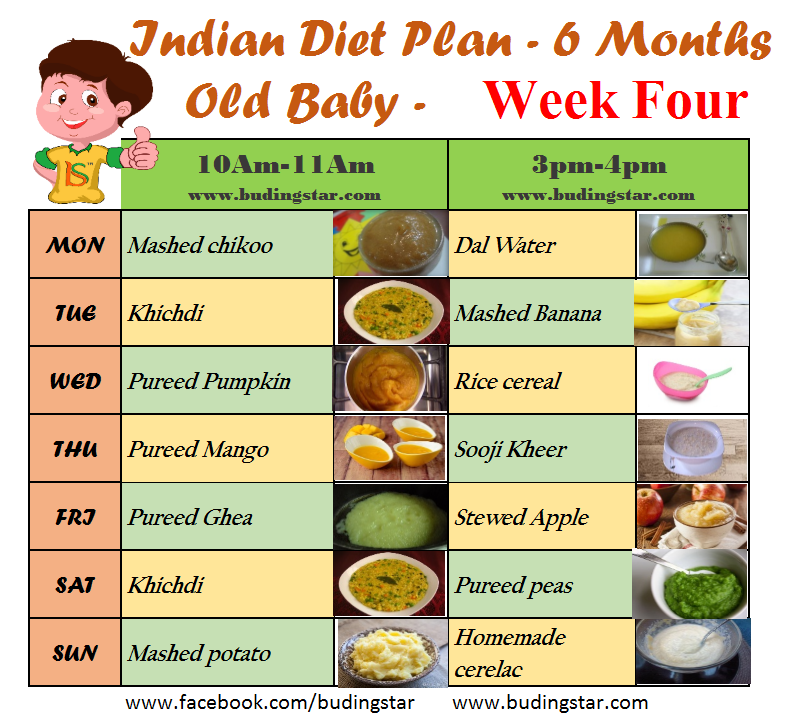
As your baby gets older – and their tummy gets bigger – they'll drink fewer bottles a day with more formula in each. It's important not to overfeed your baby so they'll stay at a healthy weight. Your baby shouldn't have more than 32 ounces of formula in 24 hours.
When they reach their first birthday, they can stop drinking formula and transition to cow's milk in a bottle, sippy cup, straw cup, or open cup. Limit your toddler to 16 to 24 ounces (2 to 2.5 cups) a day of whole milk, so they have room for other healthy foods.
Here are signs that your baby's getting all the formula they need:
- Steady weight gain. They continue to gain weight after their first 10 days and follow a healthy growth curve during their first year. (Most babies lose up to 7 to 10 percent of their birth weight in the first few days and then regain it by the time they're about 2 weeks old.)
- Happy baby. They seem relaxed and satisfied after a feeding.

- Wet diapers. They wet two to three diapers a day in the first few days after birth. Over the next few days, the amount should increase to at least five to six wet diapers a day.
Babies are usually good at eating the amount they need, but bottle-fed babies can drink too much at times. Here are the signs that they're getting too much formula:
- Vomiting after a feeding may be a sign that your baby had too much. (Spitting up is normal, vomiting isn't.)
- Tummy pain after a feeding can also be a sign of overfeeding. If your baby draws up their legs or their tummy seems tense, they may be in pain. (See other possible reasons for stomach pain in babies.)
If your baby seems to want to eat all the time, even after finishing a bottle, talk to your pediatrician. Using a pacifier may help soothe their need to suck.
Formula-feeding tips
- In general, babies eat when they're hungry and stop when they're full, so resist the temptation to encourage your baby to finish each bottle.
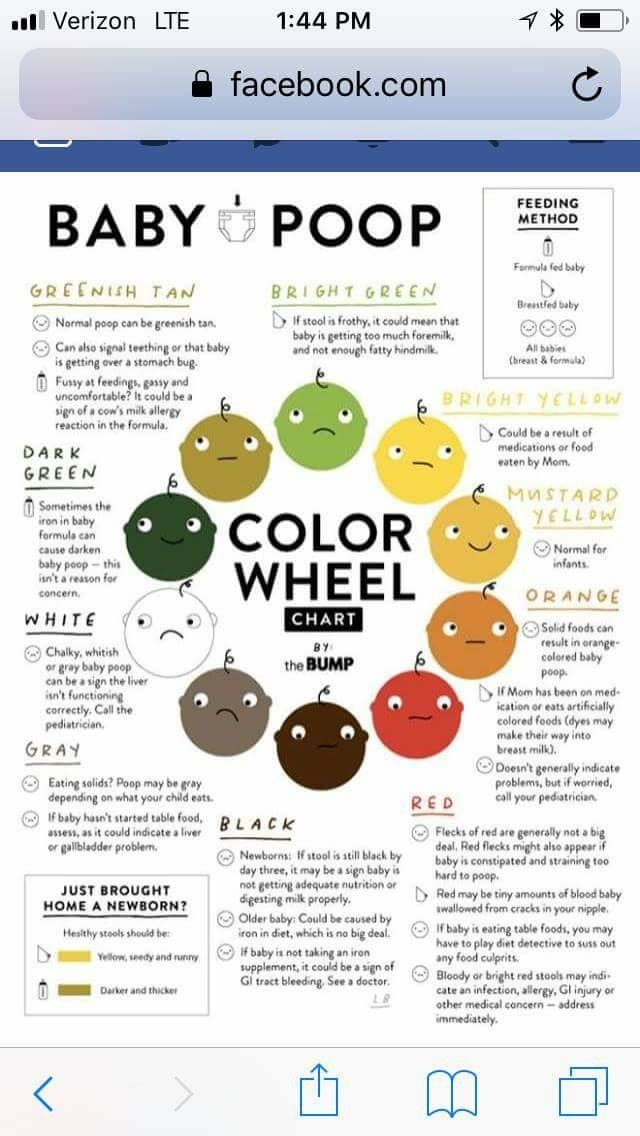 Overfeeding during infancy can contribute to obesity later in life.
Overfeeding during infancy can contribute to obesity later in life. - Don't respond to your baby's every cry with a bottle. They may be crying because their diaper is wet, they're cold or hot, they need to be burped, or they want to be close to you. (Learn more about why babies cry, and how to soothe them.)
- Your baby may be hungrier than usual during growth spurts. These typically occur 10 to 14 days after birth and around 3 weeks, 6 weeks, 3 months, and 6 months of age.
Read more:
- Formula Feeding Problem Solver
- How to safely store and use formula
How much should my baby eat? A guide to baby food portions
- Community
- Getting Pregnant
- Pregnancy
- Baby names
- Baby
- Toddler
- Child
- Health
- Family
- Courses
- Registry Builder
- Baby Products
Advertisement
Wondering how much to feed your baby? This can be hard to figure out, especially when you're starting solids and most of your baby's food ends up on your little one or the floor.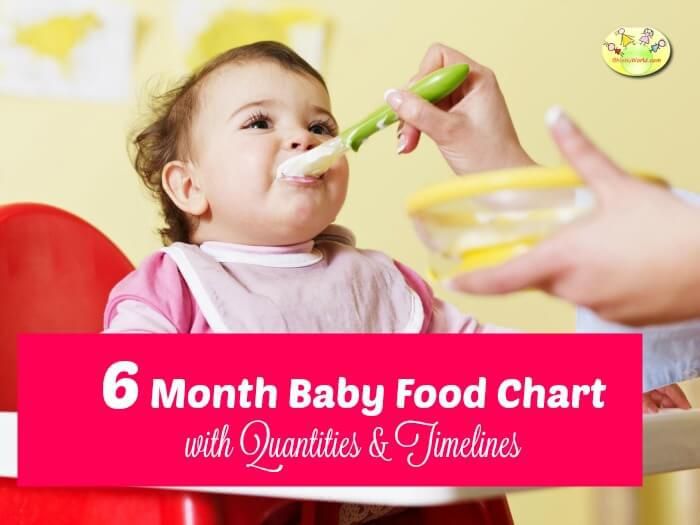 It's also difficult to determine how much an 8-month-old (or older baby) should eat – babies this age are more interested in solid foods but still get most of their nutrition from breast milk or formula. This visual guide to baby food portions can help you figure out how much your baby should eat at every stage.
It's also difficult to determine how much an 8-month-old (or older baby) should eat – babies this age are more interested in solid foods but still get most of their nutrition from breast milk or formula. This visual guide to baby food portions can help you figure out how much your baby should eat at every stage.
Photo credit: Karla Martin for BabyCenter
How much should my baby eat?
Do you worry that your baby is eating too little or too much? Your baby will self-regulate her food intake based on what their body needs, so let their appetite be your guide.
It's helpful to have a reference point, however. Here are photos of how much solid food a baby typically eats in a day. You can also ask your baby's doctor for feeding advice.
This visual guide shows:
- Portions for infants who are new to solids (typically 4 to 6 months)
- Two sample meals for a younger baby (6 to 8 months)
- Three sample meals and two snacks for an older baby (8 to 12 months) from a menu developed by the American Academy of Pediatrics (AAP)
Your little one may eat less or more than what's shown here. Your job is to provide a variety of healthy foods at regular intervals without pressure, and their job is to decide what and how much to eat.
Your job is to provide a variety of healthy foods at regular intervals without pressure, and their job is to decide what and how much to eat.
Photo credit: iStock.com / UntitledImages
Watch for signs your baby is full
Lots of factors – including activity level, growth spurts or plateaus, illness, and teething – will affect your baby's appetite, which can vary daily.
End feeding when they signal that they're done. Signs of being full include:
- Turning their head away
- Refusing to open their mouth for another bite after they've swallowed (resist the urge to encourage your baby to have one last spoonful)
- Leaning back in their chair
- Playing with the spoon or food rather than eating
Photo credit: Karla Martin for BabyCenter
How much a 4- to 6-month-old should eat
When your baby is developmentally ready for solids, typically around 4 to 6 months, talk to their doctor about introducing solid foods. The first bites are mostly about them getting used to the idea of having something different in their mouth.
The first bites are mostly about them getting used to the idea of having something different in their mouth.
- Start with a very small amount, 1 to 2 teaspoons, of a single-ingredient puree.
- Gradually increase to 1 to 2 tablespoons of food once a day.
- Follow your baby's fullness cues.
Popular first foods include pureed mango, banana, chicken, turkey, beef, peas, sweet potatoes, and infant cereal. It's up to you what food to start with, but wait 3 to 5 days between introducing each new food to make sure your baby doesn't have an allergic reaction or food intolerance. (And remember, no cow's milk or honey until age 1.)
Photo credit: Karla Martin for BabyCenter
How much a 6- to 8-month-old should eat
As your little one gets more comfortable with solids, you can increase the frequency of meals and variety of food.
- Transition from one to two meals a day, typically by 8 months.
- Over time, add a second food to each meal.
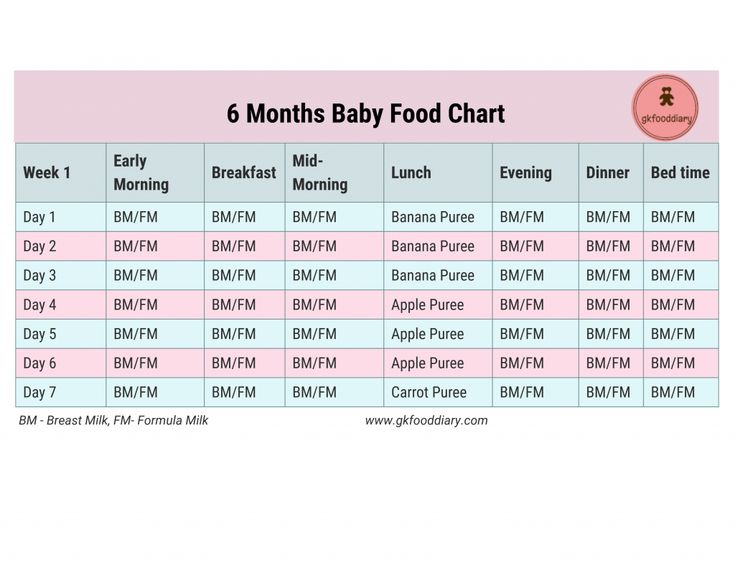 The photo above is an example of a meal with two foods.
The photo above is an example of a meal with two foods. - Once you've worked up to two meals with two foods each, aim for a balance of proteins, vegetables, fruits, and grains in their daily diet.
- Whenever you introduce a new food, start with a very small amount, a teaspoon or two, to allow your baby to get used to its flavor and texture.
- Start with a soupy consistency. Gradually add more texture as their eating skills improve.
Expect their intake of breast milk or formula to go down. They'll start drinking less of it as they eat more solid foods. Provide healthy options at mealtimes, and let them choose how much to eat.
Note: The jars in all photos are standard 4-ounce baby food jars.
Photo credit: Karla Martin for BabyCenter
Breakfast for a younger baby (6 to 8 months)
Cereal and fruit make an easy combination for a morning meal.
Grain: Iron-fortified, whole-grain infant cereal is a popular first grain.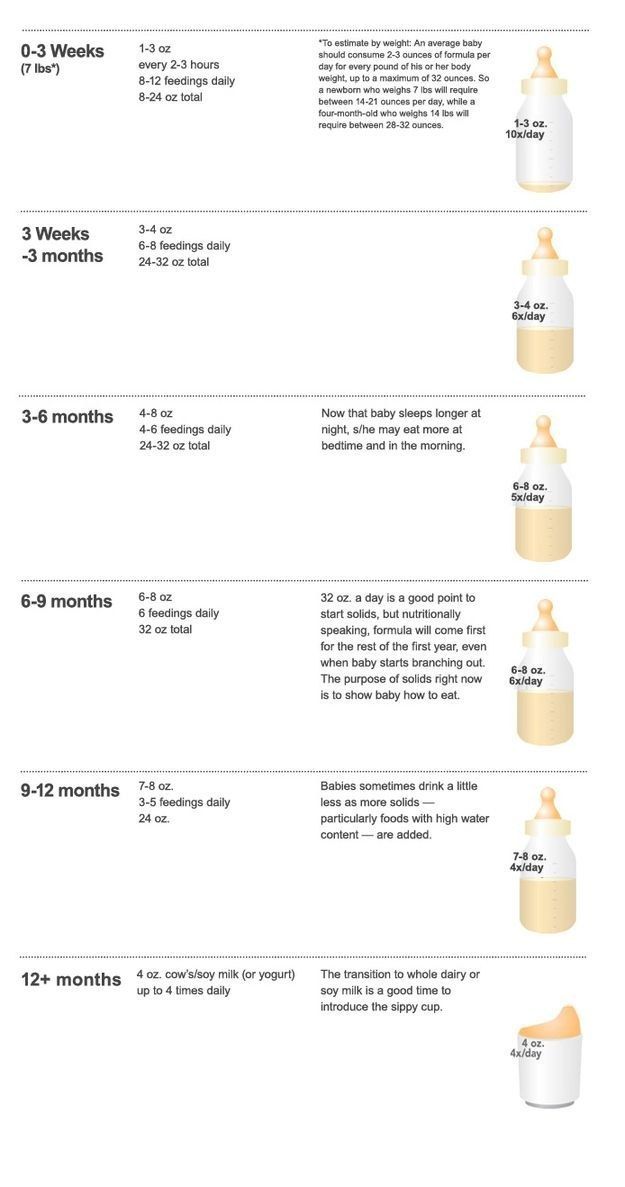 At 6 months, a typical daily portion of infant cereal mixed with breast milk or formula might be 2 to 3 tablespoons, increasing to 4 to 8 tablespoons (1/4 to 1/2 cup) by 8 months. (It's best to avoid rice cereal, though.)
At 6 months, a typical daily portion of infant cereal mixed with breast milk or formula might be 2 to 3 tablespoons, increasing to 4 to 8 tablespoons (1/4 to 1/2 cup) by 8 months. (It's best to avoid rice cereal, though.)
Fruit: Babies love the natural sweetness of fruits like pears, apples, berries, prunes, and stone fruits. Between 6 and 8 months, a baby will typically transition from about 2 to 3 tablespoons of fruit puree a day to 4 to 8 tablespoons (1/4 to 1/2 cup) of mashed or minced fruit.
Photo credit: Karla Martin for BabyCenter
Dinner for a younger baby (6 to 8 months)
If you serve a grain and fruit in the morning, consider offering a protein-rich food and vegetable later in the day. Your child may eat more or less than the amounts shown.
Protein: A baby might transition from eating 1 to 2 tablespoons of meat puree at 6 months to 2 to 4 tablespoons at 8 months, for example. Other good protein sources include cheese, unsweetened plain whole-milk yogurt, tofu, beans, and lentils.
Vegetables: Between 6 and 8 months, a baby will typically transition from about 2 to 3 tablespoons of vegetable puree a day to 4 to 8 tablespoons (1/4 to 1/2 cup). Try classic favorites like carrots, spinach, or butternut squash, as well as less traditional first foods such as parsnips, beets, or asparagus.
As your child's eating skills improve, gradually add more texture by dicing or mincing foods.
Photo credit: Karla Martin for BabyCenter
How much an 8- to 12-month-old should eat
By 8 months or so, your baby is likely getting the hang of eating and needs to eat more calories to support their growing body. But since their little belly can't hold a lot of food, they'll need to eat more often. Every baby is different, but this may be a good time to try offering a third solid food meal.
During this period:
- Continue to give your baby breast milk or formula.
- Add morning and afternoon snacks. (Some babies this age are happy with breast milk or formula as their snack, while others gravitate toward solid foods.
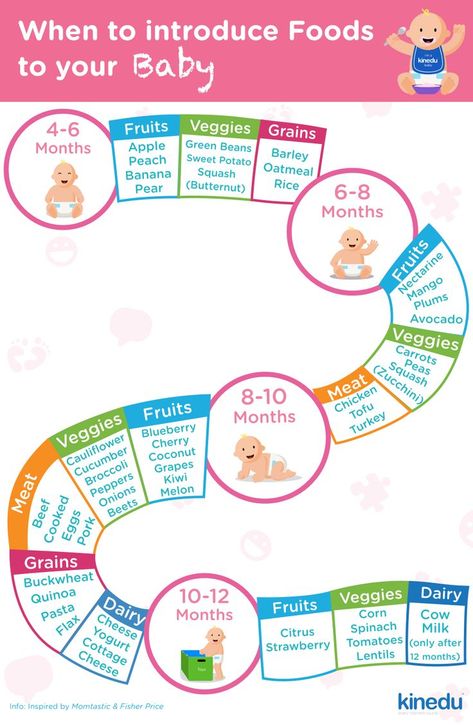 ) Once you've added a third meal and snacks, your baby will be eating or drinking something about every two to three hours.
) Once you've added a third meal and snacks, your baby will be eating or drinking something about every two to three hours.
- Continue to aim for a mix of proteins, vegetables, fruits, and grains.
- Introduce coarser and chunkier textures, for example, by dicing or mincing food instead of pureeing it, and graduate to soft finger foods as your baby's eating skills improve.
- Avoid foods with added sugars. Check the Nutrition Facts label on packaged foods, and try to steer clear of foods that list 1 gram or more of "Added Sugars."
- Provide healthy options, and let your baby choose how much to eat.
To visualize daily portions for an 8- to 12-month-old, check out the following photos of a typical day's menu for a baby this age, developed by the AAP.
Your child may eat more or less than these amounts. If you're concerned about how much your baby is eating, talk to their doctor for advice.
Photo credit: Karla Martin for BabyCenter
Breakfast for an older baby (8 to 12 months)
The AAP sample menu for a baby 8 to 12 months features a breakfast consisting of:
- 4 to 8 tablespoons (1/4 to 1/2 cup) whole-grain infant cereal mixed with formula or breast milk
- 4 to 8 tablespoons (1/4 to 1/2 cup) diced fruit
Note: This is an example.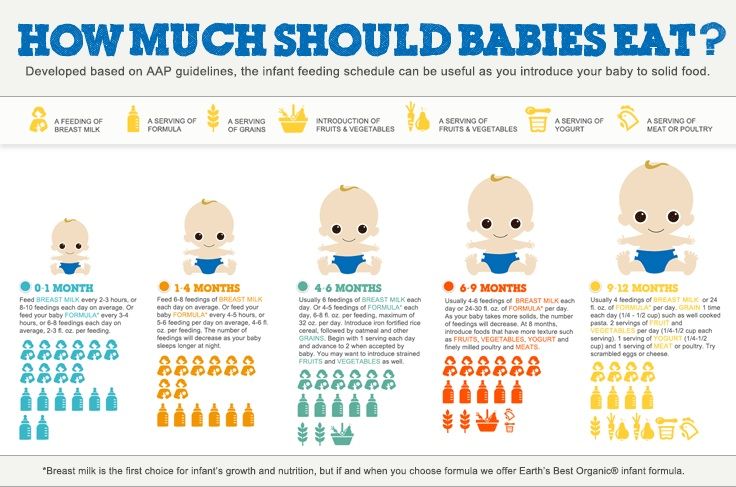 Your baby may eat different foods and amounts.
Your baby may eat different foods and amounts.
Photo credit: Karla Martin for BabyCenter
Morning snack for an older baby (8 to 12 months)
The AAP sample menu for a baby 8 to 12 months features a morning snack consisting of:
- 4 tablespoons (1/4 cup) diced cheese or cooked vegetables
Note: This is an example of a morning snack, which babies typically add sometime between 8 and 12 months. Your baby may eat different foods and amounts.
Photo credit: Karla Martin for BabyCenter
Lunch for an older baby (8 to 12 months)
The AAP sample menu for a baby 8 to 12 months features a lunch consisting of:
- 4 to 8 tablespoons (1/4 to 1/2 cup) unsweetened plain whole-milk yogurt or cottage cheese, or minced meat
- 4 to 8 tablespoons (1/4 to 1/2 cup) diced or mashed yellow or orange vegetable
Note: This is an example. Your baby may eat different foods and amounts.
Photo credit: Karla Martin for BabyCenter
Afternoon snack for an older baby (8 to 12 months)
The AAP sample menu for a baby 8 to 12 months features an afternoon snack consisting of:
- 4 tablespoons (1/4 cup) diced fruit or unsweetened plain whole-milk yogurt
- 1 whole-grain teething biscuit or cracker
Note: This is an example of an afternoon snack, which babies typically add sometime between 8 and 12 months.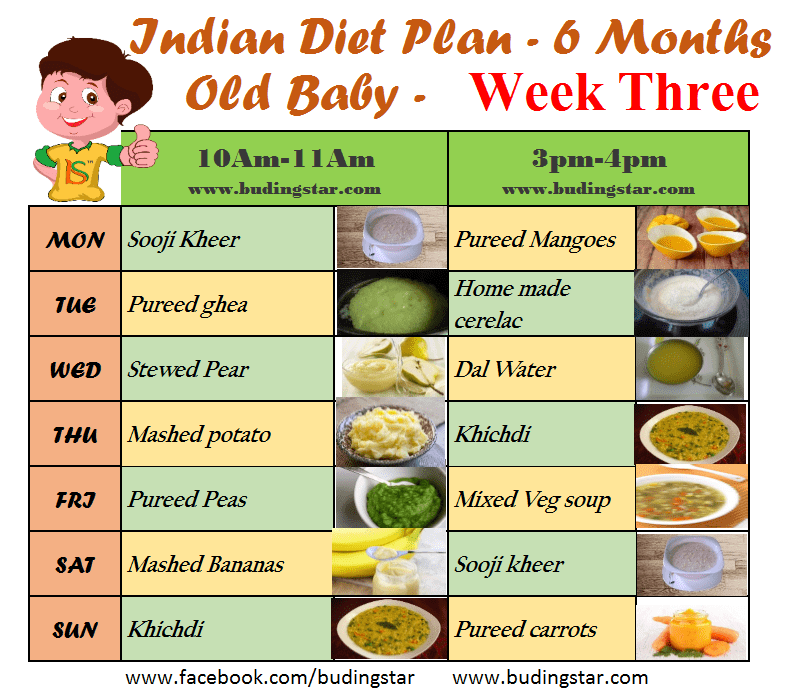 Your baby may eat different foods and amounts.
Your baby may eat different foods and amounts.
Photo credit: Karla Martin for BabyCenter
Dinner for older baby (8 to 12 months)
The AAP sample menu for a baby 8 to 12 months features a dinner consisting of:
- 4 tablespoons (1/4 cup) minced or ground poultry or meat, or diced tofu
- 4 to 8 tablespoons (1/4 to 1/2) cup diced, cooked green vegetable
- 4 tablespoons (1/4 cup) noodles, pasta, rice, or potato
- 4 tablespoons (1/4 cup) diced fruit
Note: This is an example. Your baby may eat different foods and amounts.
Photo credit: Karla Martin for BabyCenter
How much should my baby drink once they start eating solids?
Breast milk or formula will fully meet your child's hydration needs until they're about 6 months old. They may start drinking less as solid foods become a bigger part of their diet. Here are typical daily amounts by age – your baby's intake may be different, however.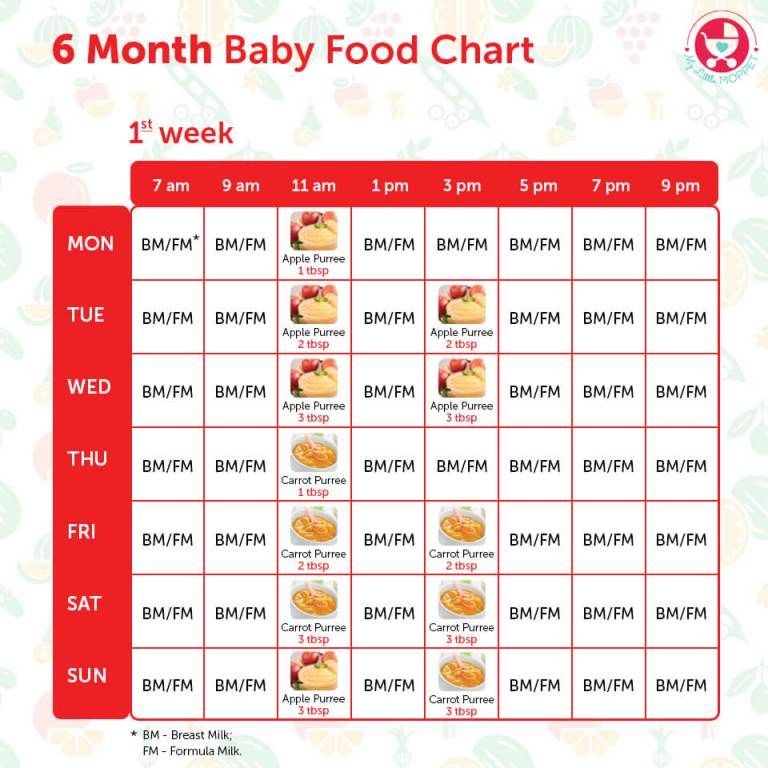
6 to 8 months: 24 to 32 ounces of formula, or continued breastfeeding on demand
8 to 12 months: 24 ounces of formula, or continued breastfeeding on demand
Water: You can offer your baby water once they start eating solids, but let them self-regulate how much they drink. The Centers for Disease Control and Prevention (CDC) recommends giving babies who are 6 to 12 months old 4 to 6 ounces of water a day, but what your baby decides to drink may vary. They may drink more on a hot day, for example.
Avoid juice: Juice isn't recommended for babies younger than 12 months.
Photo credit: iStock.com / SDI Productions
Your baby has the final say
Keep in mind that these portions are an estimate. The truth is, every baby is different, and there's no set amount of food that's appropriate for every baby at every stage.
If you're worried about whether your baby is eating enough – or too much – the best advice is to look for and respond to signs that your baby is full.![]()
Your baby's doctor will chart their weight gain at regular intervals. If the doctor sees a consistent growth curve and doesn't have other concerns, your baby is most likely eating the right amount of food.
Hungry for more?
Age-by-age guide to feeding your baby
The 10 best foods for babies
The worst foods for babies
Using spices and seasoning in baby food
Elizabeth Dougherty
Elizabeth Dougherty is a veteran parenting writer and editor who's been contributing to BabyCenter since 2015. She's an intrepid traveler, devoted yogi, and longtime resident of Silicon Valley, where she lives with her husband and son.
Advertisement | page continues below
Scheme of the first feeding of a child (table) with artificial and breastfeeding, what can be given to a baby
The need for the introduction of complementary foods in modern mothers has long been beyond doubt. Pediatricians, pediatric nutritionists and other graduates unanimously say that at some point both mother's milk and formula are not enough to satisfy the growing needs of the child's body for useful trace elements and vitamins.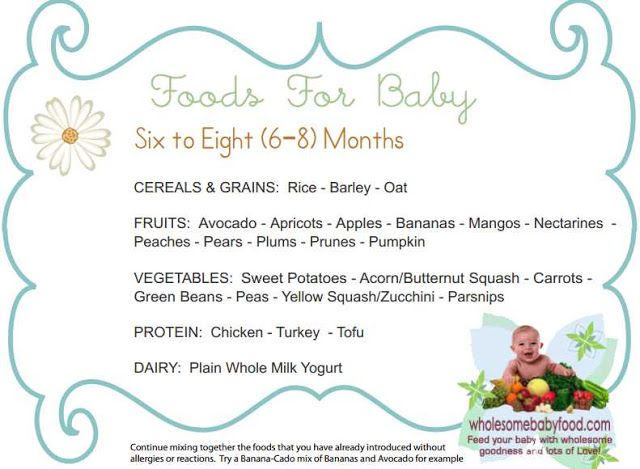 That's when it's time to introduce complementary foods. The fact that your baby is ready to get new experiences and try tastes so far unknown to him is indicated by the presence of the following signs:
That's when it's time to introduce complementary foods. The fact that your baby is ready to get new experiences and try tastes so far unknown to him is indicated by the presence of the following signs:
• doubling the initial weight of the child,
• ability to sit with support,
• child does not push food out of his mouth,
• curiosity and desire to try something from the common table.
Signs of malnutrition in a child, constant feeling of hunger and anxiety associated with it, weight loss can also be important signals for the start of complementary foods. In these cases, it is recommended to immediately contact a specialist and share your observations with him.
Contents: Hide
- When to start the introduction of complementary foods
- with which products to start the completenance of complementary foods
- We avoid errors
- Table of complementary foods for months with artificial feeding
- Table of complementary foods when breastfeeding
- start introducing complementary foods
The timing of the introduction of complementary foods is still debated.
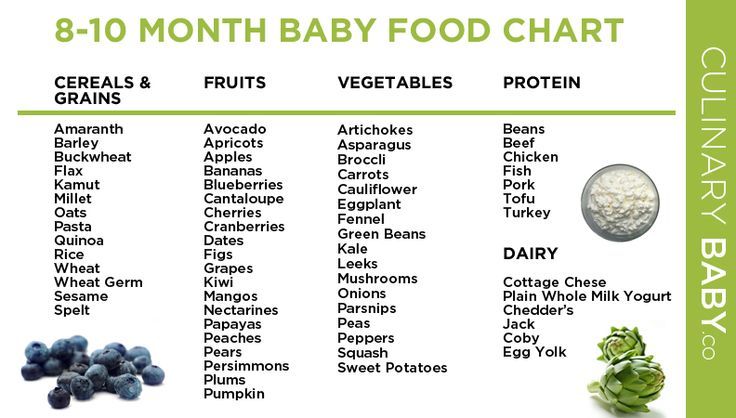 But if we bring scientific reasoning to a common denominator, then the conclusion suggests itself that complementary foods can be introduced from about six months, and for children with certain medical indications - from 3-5 months. Many experts believe that half a year is the ideal time for complementary foods, when the first colic is over, and the digestive system has matured enough to try new foods. The exact answer to the question of when to introduce complementary foods in a particular child can only be given by a pediatrician. In some situations, it may be necessary to introduce new dishes into the baby's diet as early as 4 months, and someone will be ready for this only after six months.
But if we bring scientific reasoning to a common denominator, then the conclusion suggests itself that complementary foods can be introduced from about six months, and for children with certain medical indications - from 3-5 months. Many experts believe that half a year is the ideal time for complementary foods, when the first colic is over, and the digestive system has matured enough to try new foods. The exact answer to the question of when to introduce complementary foods in a particular child can only be given by a pediatrician. In some situations, it may be necessary to introduce new dishes into the baby's diet as early as 4 months, and someone will be ready for this only after six months. What foods should I start introducing complementary foods with
Fruits, vegetables or cereals? Which of these foods are best for starting complementary foods? Experts have long answered this question as follows: if the baby is underweight, suffers from frequent loose stools, it is advisable to start with cereals (of course, gluten-free and dairy-free), and if everything is fine with weight, then vegetables will be the first in line.
 Also, vegetable complementary foods are recommended for breastfed children with constipation problems, rickets, or those born prematurely, whose weight is normal or exceeds the standards.
Also, vegetable complementary foods are recommended for breastfed children with constipation problems, rickets, or those born prematurely, whose weight is normal or exceeds the standards.
Why not fruit? Everything is simple. Fruits have a bright and sweet taste, and after trying an apple or banana first, the baby is likely to refuse zucchini or broccoli, which do not have the same rich taste. Therefore, the introduction of fruit purees and juices into the diet is postponed until vegetable purees become a familiar dish on the menu. As for cereals, buckwheat, rice and corn are first introduced, as they are characterized by the absence of gluten, saturate and are well digested.Read also: How to properly teach a child to different tastes
Avoiding mistakes
In order for the introduction of complementary foods not to become a test for either the baby or the mother, you need to follow some recommendations. Most importantly, be patient and don't get too upset if things don't go according to plan.
 Each child is individual, as are their taste preferences and needs.
Each child is individual, as are their taste preferences and needs.
• Start complementary foods if the baby is perfectly healthy. Contraindications for the introduction of new products will be teething, colds, stress associated with separation or moving, recent or planned vaccinations.
• New foods are introduced gradually, starting with half a teaspoon. In the absence of allergies or digestive problems, the amount of the product is approximately doubled the next day. Sometimes the introduction of a new product stretches up to a week. Do not rush, give the child the opportunity to "taste" this dish. If the baby flatly refuses the offer, postpone the acquaintance for at least a week.
• Do not force your child to eat. After all, your goal is to introduce your child to new tastes and help develop good eating habits.
• The best time for the first feeding is after the morning feed until 12 noon, when the baby is already hungry and ready to eat something else. In case something goes wrong, you will know about it during the day, not at night.
• In the event of an adverse reaction to the product, such as an allergy, seek medical advice immediately. Then, in agreement with the doctor, offer this dish after a certain period of time.
• Gradually increase the amount recommended by your pediatrician. If you don't fit within a week, don't worry. Listen to your child and act accordingly.
• Always start feeding with complementary foods. Only then offer breast milk or formula.
• Stick to a 5-meal schedule. Feed your baby at the same time every day.
• Food offered to the baby must be thermally processed - boiled or steamed. The dish should be at a comfortable temperature - about 37 ° C.
• Purees and cereals should be of a liquid consistency so that a child who does not yet know how to chew can comfortably eat them. Thicker dishes with lumps and pieces are introduced into the diet by about a year, when there are already several teeth.
• Do not use salt, sugar or spices when preparing complementary foods.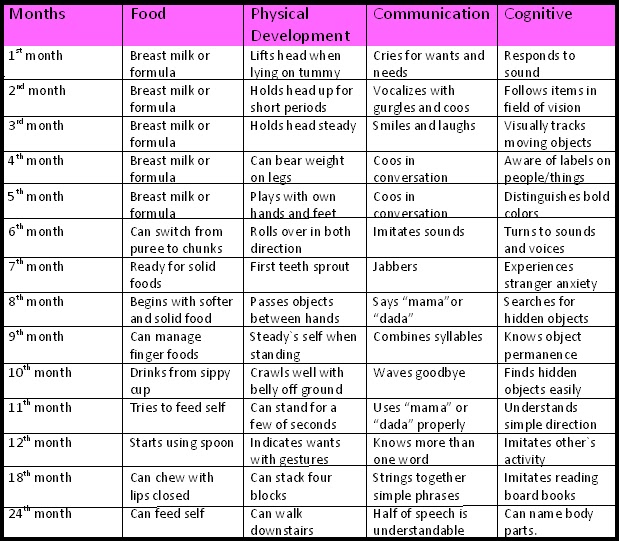 Also, do not add them in order to force the child to eat something. Let the baby get used to natural tastes.
Also, do not add them in order to force the child to eat something. Let the baby get used to natural tastes.
• Complementary foods are prepared at one time and should never be refrigerated until the next meal. Everything should be only the first freshness.
• If you prefer ready-made baby food, carefully study the top manufacturers, pay special attention to the shelf life when buying.When introducing complementary foods, be guided by the data in the tables, which indicate which products, in what quantity and in what months experts recommend giving. 6 months
7 months
8 months
9 months
10 months
11 months
12 months
0068
180 g
200 g
200 g
Porridge
50–100 g
150 g
068
180 g
180 g
180 g
200 g
200 g
fruit
60 g
70 g
80 g
100 g
100 g
100 g
meat
50 g
60 g
60 g 9000
70 g
70 g
70 g
Cottage cheese
9000
068
10-30 g
30 g
40 g
50 g
50 g
Zhelki
1/4
1/4
1/2
1/2
1/2
Fish
9000
30 g
50 g
60 g
Vegetable
1 ml
3-5 ml
5 ml
5 ml
5 ml
9 Sl.
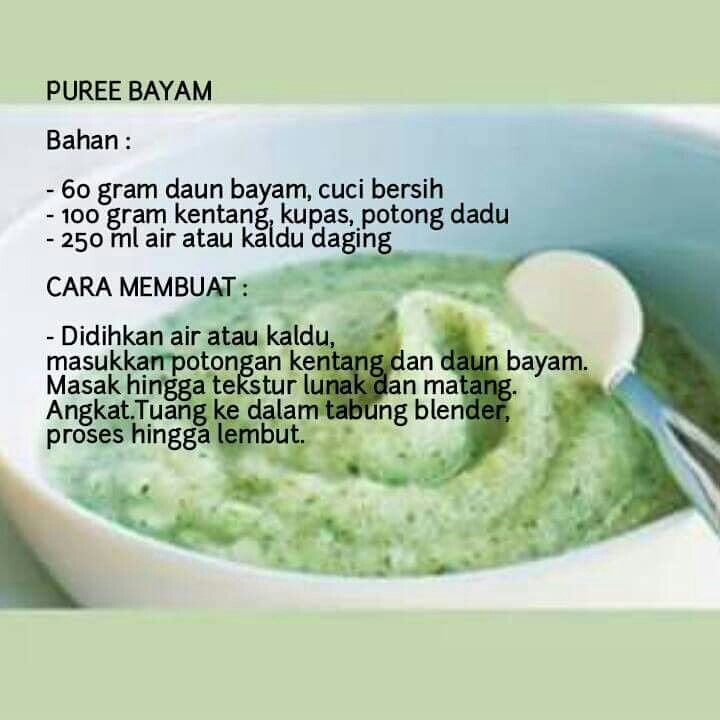
1 ml
3-5 ml
5 ml
5 ml
9006 8 months
9 months
10 months
11 months
12 months
Silent porridge
10–150 g
150–180 g
150–180 g
180–200 g 9000 g 9000 g 9000 g 9000 g 9000 g 9000 g 9000 g 9000 g 9000 g 9000 g
068
200 g
200 g
200 g
Vegetables
10–120 g
80–120 g
9000 9000 9000 9000 9000 9000 9000 9000 9000073
150 g
170 g
180 g
200 g
200 g
Military0007
-
-
-
-
-
-
160–200 ml
Fruits
5–60 g
50-60 g
60 g 9000 g 9000 g 900–100 g 900-100 G0007
100–120 g
100–120 g
100–120 g
meat
-
10-30 g
30–70 g
60–70 g
60–70 g
9000 9000
9007 9007 9007 9007 900EA0119 Cottage cheese -
-
5–10 g
40 g
40 g
50 g
yolk
-
-
½
½
½
½ --1
fish
-
-
-
10–40 g
10–40 g
50–60 g
9 vegetable oil
-
-
1 ml
3-5 ml
5 ml
5 ml
5 ml
Cream oil
-
-
1-3 g
3-4 g
5 g
5 g
5 g
, as you can see, the schemes for the introduction of pectoral and artificial feeding are not too much.
 In any case, starting to introduce new foods into the baby's diet, you will have to give the baby milk or formula for a long time, which are still the basis of his nutrition.
In any case, starting to introduce new foods into the baby's diet, you will have to give the baby milk or formula for a long time, which are still the basis of his nutrition. How to introduce solid foods by month
3 months
If your doctor advises your breastfeeding or formula-fed baby to introduce complementary foods at 3 months, start with what the specialist has recommended to you. If these are vegetables, start with the classic - zucchini puree. This vegetable contains many beneficial nutrients and fiber. Start with half a teaspoon, carefully observing the reaction of the child's body. Be sure to supplement your baby with breast milk or formula afterwards. In case the child does not like the zucchini, try giving broccoli or cauliflower. Well, if the doctor advised porridge, feel free to choose buckwheat or corn.
4-5 months
After your baby has tasted zucchini, broccoli and cauliflower, it's time to add other vegetables: carrots, potatoes, green peas. Do not overdo it with carrots, give it no more than 2 times a week. It is even better if this root crop is combined with other vegetables. It's porridge time! Gluten-free, water-cooked buckwheat, rice or corn. If the baby refuses to eat such cereals, add some breast milk or the usual mixture to them.
Do not overdo it with carrots, give it no more than 2 times a week. It is even better if this root crop is combined with other vegetables. It's porridge time! Gluten-free, water-cooked buckwheat, rice or corn. If the baby refuses to eat such cereals, add some breast milk or the usual mixture to them.
6 months
Time to pamper your baby with dried fruit compote, and formula-fed children start giving milk porridge. You can use a milk mixture to prepare such cereals, and in some cases, milk diluted with water. But in general, pediatricians do not advise introducing cow's milk into a child's diet before 8 months, as this can cause allergic reactions.
7 months
After the baby gets used to vegetable purees, you can try to give fruit purees and, if desired, juices, which should be diluted with water. There has been a lot of negative talk about juice lately. There is no fiber in them, but there are a lot of acids, which may not be completely safe for the stomach and have a high sugar content. So consult a pediatrician and think carefully about whether to give the baby juices or still prefer mashed potatoes and compotes. An excellent alternative to juices is children's herbal teas. Start introducing your baby to fruits with apples (preferably green varieties), bananas, and pears. The baby's menu is replenished with a new product - meat. Rabbit meat, turkey meat are best suited. Chicken and veal are also considered a good option. Low-fat pulp without streaks is taken. It is boiled or brought to readiness for a couple, then crushed in a blender or meat grinder. Meat with a gradual increase in its quantity is given as part of vegetable purees. Also at 7 months, it's time to give the baby a pumpkin.
So consult a pediatrician and think carefully about whether to give the baby juices or still prefer mashed potatoes and compotes. An excellent alternative to juices is children's herbal teas. Start introducing your baby to fruits with apples (preferably green varieties), bananas, and pears. The baby's menu is replenished with a new product - meat. Rabbit meat, turkey meat are best suited. Chicken and veal are also considered a good option. Low-fat pulp without streaks is taken. It is boiled or brought to readiness for a couple, then crushed in a blender or meat grinder. Meat with a gradual increase in its quantity is given as part of vegetable purees. Also at 7 months, it's time to give the baby a pumpkin.
8 months
An important moment in the introduction of complementary foods during artificial and breastfeeding occurs exactly at 8 months. It's time to give the baby a yolk. Watch the reaction of the body very carefully: if there are any manifestations of allergies.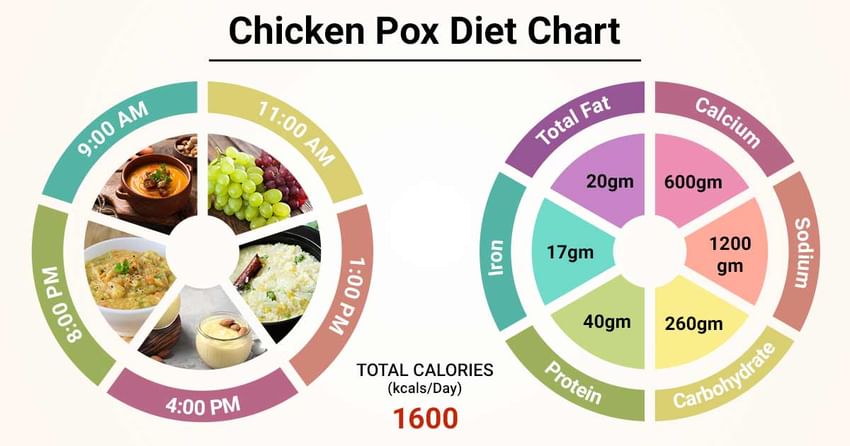 In case of a negative reaction of the body to chicken yolk, exclude it from the menu and try quail. It is best to give this product in the morning feeding from 9 to 11 hours. Along with vegetable and butter, gluten cereals are also introduced: oatmeal, millet, barley, pearl barley. It's time to give your child a taste of light vegetable soups. The components of the dish should be familiar to the child. Do not experiment by introducing dishes into the diet even with one unknown ingredient. Meatballs, boiled or steamed, are added to the meat in the form of mashed potatoes.
In case of a negative reaction of the body to chicken yolk, exclude it from the menu and try quail. It is best to give this product in the morning feeding from 9 to 11 hours. Along with vegetable and butter, gluten cereals are also introduced: oatmeal, millet, barley, pearl barley. It's time to give your child a taste of light vegetable soups. The components of the dish should be familiar to the child. Do not experiment by introducing dishes into the diet even with one unknown ingredient. Meatballs, boiled or steamed, are added to the meat in the form of mashed potatoes.
9 months
At this age, the baby should be introduced to the diet of low-fat fish: pollock, hake, perch, cod. For these purposes, fillets are taken and steamed, stewed or boiled. For the first time, fish are given in very small quantities. Start with once a week, gradually increasing to two. Remember that either fish or meat is given on the same day, without mixing these 2 products. If at the age of 8 months there were no prunes on the menu of the child, it's time to fix it.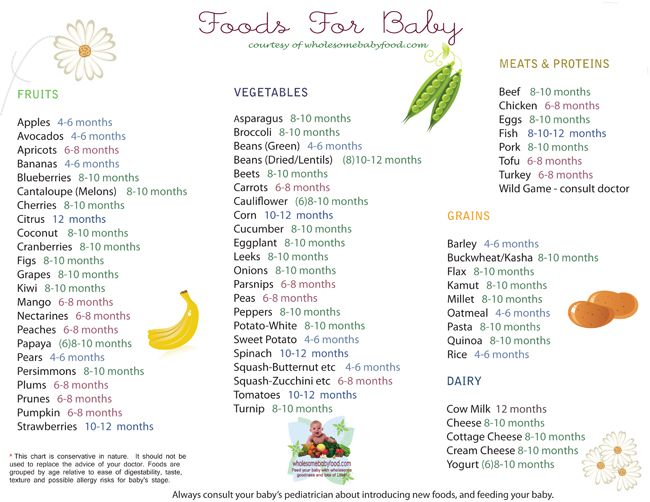 Dried fruit compote is also an excellent option, which at first is best diluted with water. However, you definitely shouldn’t get carried away with dried apricots, it’s better to wait until the baby reaches the age of one.
Dried fruit compote is also an excellent option, which at first is best diluted with water. However, you definitely shouldn’t get carried away with dried apricots, it’s better to wait until the baby reaches the age of one.
Months 10–12
The diet characteristic of this period is characterized by an increase in portions to their maximum values indicated in the scheme. Also, it is at this age that the last feeding is gradually replaced by milk or kefir.Now that you've come across a set of essential tips, you're ready to start weaning. Once again, consult with a specialist, be patient, not forgetting to listen to the baby's body. We are confident that you will succeed. The main thing here, as in any other business, is a positive attitude. It all depends on you and your desire to raise a healthy and happy baby with competent eating behavior. Don't stop if you fail and don't get frustrated if things don't go according to plan. Everything will definitely work out.

#Nutrition for children under one year of age #Complementary foods
WHO recommendations for the introduction of complementary foods
08.08.2019
Readiness of the child to complementary foods According to the WHO recommendation, existing for 2018, it is optimal to introduce complementary foods to an infant at 6-8 months. Until six months, the baby's gastrointestinal tract is still not sufficiently formed, all the necessary enzymes are not produced for the assimilation of food other than mother's milk or formula. And by 9-10 months, the child can already form stable stereotypes of eating only liquid food, and overcoming them will be painful and difficult for the baby.
Thus, WHO defines the following signs of a child's readiness for the introduction of complementary foods: the maturity of the digestive system; extinction of the solid food ejection reflex; the appearance of the first teeth, making it possible to chew; the readiness of the baby to be stable in an upright position; emotional readiness for new tastes and sensations.

Complementary feeding system WHO has developed recommendations for three complementary feeding options: cereals, vegetables, and meat.
Fruit complementary foods are not recommended for cereals and vegetables. This is due to the fact that up to 8-9 months the gastrointestinal tract of the baby is not ready for the absorption of raw fruits and fruit juices. It is vegetables and cereals that will populate the intestines with the necessary bacteria for the absorption of fruits.
Kefir, according to the WHO, is not considered complementary foods because it is not a solid food. The WHO complementary feeding scheme includes kefir only as an additional food from 8 months. The introduction of cow's milk is recommended by WHO only from 12 months.
Any complementary feeding scheme assumes that portions of complementary foods will systematically increase from half a teaspoon to 100-200 g. The first dishes for complementary foods are prepared exclusively with one-component.
 Each next component is introduced only after complete addiction to the previous one (6-7 days).
Each next component is introduced only after complete addiction to the previous one (6-7 days). Product sequence
The following sequence of introduction of complementary foods is proposed.
- Vegetables at 6 months.
- Porridges on the water (oatmeal, buckwheat, corn) at 6.5 - 7 months.
- Fruit puree, yolk at 8 months.
- Milk porridge at 8-9 months.
- Meat puree at 9 months.
- Meat by-products at 9-10 months.
- Kefir, cottage cheese, yogurt at 9-10 months.
- Fish at 10 months.
- Juice at 10-12 months.
- Berry puree at 12 months.
- Meat broths at 12 months.
The introduction of vegetable oil (olive, sunflower) in puree and porridge is allowed from 6 months: a scheme with 1 drop with a gradual increase to a volume of 1 teaspoon. The introduction of butter begins at 7 months: the scheme is from 1 g to 10 g in porridge.

For formula-fed babies, the first feeding schedule is similar, with a few exceptions. For these babies, it is better to introduce complementary foods from 5 months, because the milk mixture does not give the small body all the “building material”. The introduction of complementary foods differs only in terms: vegetable purees and cereals are introduced a month earlier.
First cereals
If the child's weight is significantly less than normal, WHO recommends starting complementary foods with non-dairy cereals. For babies, cereals are prepared only with non-dairy, unsalted, semi-liquid, absolutely homogeneous in consistency. The first cereals are prepared from cereal flour (the sorted and washed cereals are carefully ground and crushed).
The following sequence of introduction of cereals is proposed: buckwheat, rice, corn, oatmeal, semolina. It is recommended to cook semolina porridge only once a week, because it contains practically no nutrients, but it is rich in gluten, which can cause problems in the intestines.
 Proportion for the preparation of the first porridge: 5 g of cereal flour per 100 ml of water. After slightly cooling the finished porridge, chop again. In the finished porridge, you can add 1-2 drops of vegetable oil or a little expressed breast milk.
Proportion for the preparation of the first porridge: 5 g of cereal flour per 100 ml of water. After slightly cooling the finished porridge, chop again. In the finished porridge, you can add 1-2 drops of vegetable oil or a little expressed breast milk. From 9 months, the baby's nutrition system involves multicomponent cereals, from products already well known to the child. You can already add vegetables and fruits familiar to the baby to cereals. At 9 months, it is allowed to cook barley and millet porridge for babies. And by 10-11 months, cereals on the water will be a great addition to meat and fish meatballs and steam cutlets.
Vegetable food
The first purees are made from one vegetable.
The sequence of introducing vegetables into complementary foods for babies suggests the following order: zucchini, cauliflower, pumpkin, potatoes, carrots, green peas, beets. These vegetables are introduced within 6-9baby months. After 1 year, you can give your child cucumbers, eggplants, tomatoes, sweet peppers, white cabbage.
 After preparing the puree, make sure that the mass is completely homogeneous, there are no fibers and small particles, the consistency is semi-liquid. Don't salt. Add 1-2 drops of vegetable oil or expressed milk.
After preparing the puree, make sure that the mass is completely homogeneous, there are no fibers and small particles, the consistency is semi-liquid. Don't salt. Add 1-2 drops of vegetable oil or expressed milk. If the child refuses vegetable complementary foods, cancel this product for 1-2 weeks. Try to temporarily replace it with another and return to it after a while.
Meat supplements
From 9 months old, the first meat purees are recommended for babies. The first courses are recommended to be prepared from lean meats: rabbit; quail; turkey; chicken.
Complementary foods for a 6-month-old baby are recommended to be introduced in the morning. This will allow you to track the child's reaction to an unfamiliar product before a night's sleep: is there a rash, intestinal disorders, anxiety in the baby, profuse regurgitation. It is better to give vegetables or porridge first, and then saturate with breast milk or formula. Gradually, porridge and a vegetable dish will replace one full meal.



